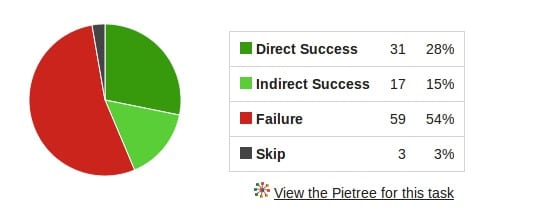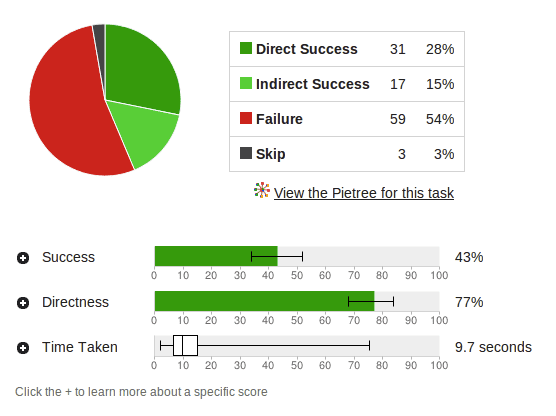7 tips for tree testing your intranet navigation

Example of basic analysis of a task used to test an intranet navigation tree
Synopsis: Tree testing is a tried and true technique for improving your intranet navigation. In this article learn how to do it right and participate in an example tree test.
It’s been a busy summer so far. As much as I’d like to have been skiving off rock climbing, I’ve been training intranet owners at a DWG consulting client in tree testing to deploy over 30 tree tests in six different languages.
We’re using it to help this large international company merge many intranet sites into one global navigation structure. With online testing we’ve gathered structured feedback from hundreds of users in a short space of time.
Fresh from being neck deep in this client’s project, I thought I would share some top tips for successful intranet tree testing.
But first the basics…
What’s an intranet tree test?
Users are set tasks and asked to explore a draft site navigation in a “tree” structure that is progressively revealed as they click on items.
Intranet tree testing can be conducted online or in-person and used to test a new or existing site structure.

Example of clickable “tree” navigation and a task to test it
Why would you need to bother with intranet tree testing?
This structured user feedback technique is great at telling you what’s wrong with your current structure. You can test the whole thing – so all your primary navigation labels at the top level – or you can deep dive into a particular area and just test that.
Regular and well-focused tests help you make continual improvements to your structure. Don’t wait for the big site overhaul that you might not get budget for. Roll your sleeves up now and get stuck in. You could improve the findability of your intranet in less than a week with very little effort.
And now for the good stuff…
So, if you’re interested in doing or are ready to do intranet tree testing, these seven tips will help you get the most out if it:
1. Don’t set more than 10 tasks at a time
We all get bored easily and your users are no different. So don’t ask too much at once or you’ll find people lose interest and start random button pressing. Let users skip tasks so that if they really don’t know, they’re not forced to make a decision.
Users also learn the tree as they go, so it’s better to set fewer tasks and do it more often to cover more ground.
2. Don’t give the game away!
Choosing the correct language for your tasks is important so that you don’t give away the answer in the question.
If your structure looks like this… Finance > Expenses > Expense reimbursement
then don’t say “expenses” and “reimbursement” in the task.
- NO: You need to get reimbursed for some expenses. Find the expense claim form.
- YES: You’ve bought a train ticket with your credit card and need to claim the money back. Where would you do this?
3. Test your study before launch
Make sure you get a colleague who doesn’t work on the intranet to test your study before you unleash it on your audience.
If you’re using an online tool, ensure employees can access it behind the firewall.
4. Launch it
Online studies can be promoted on your intranet or via email. Say how long the test will take to complete (10–15 minutes usually) and be friendly.
Three things to keep in mind:
- We found that targeted emails to users with specific profiles worked best.
- You’ll need a minimum of 30 responses to see patterns.
- If you’re conducting offline sessions you can get guerrilla about it and recruit in the corridor or in the lunch queue.
5. Be focused
Online tools can provide fancy graphs of success rates, trees that show user journeys, path analysis, first click analysis, blah, blah, blah. All very useful.
Don’t get too hooked up on all the detail if you don’t have time. Look for the weakest performing areas first; if you see red, start there.

6. Don’t be scared to make the change
You’ve seen from the mostly red pie chart where the problem is. If you can, make a change today rather than waiting for your next release or steering group discussion.
7. Make it a regular activity … make it a KPI
Conduct tree tests regularly, aggregate results and use them to measure site effectiveness. Why not set a KPI on improving overall task success rates year on year?
I’m in. Where do I go next?
Listed below are a number of online tools in no particular order:
There’s no time like right now to start tree testing your intranet. Good luck!
Related research
User-centred design (UCD) for intranet navigations
Large corporate intranets serve diverse audiences and support multiple goals, but often they have evolved with little control, reaching mammoth proportions.
In this paper we set out the steps to developing an intranet information architecture (IA) using user-centred design (UCD) techniques, starting with why it is so hard to find an intuitive IA, and key success factors.
See Also
- 5 tips for setting up an intranet card sort online
- 10 steps to interpreting intranet tree testing results
- Intranet usability: 4 data analysis steps for card sorting exercises
Categorised in: Content management, Digital workplace strategy, Intranet usability, Metrics and measurement, Search and findability
